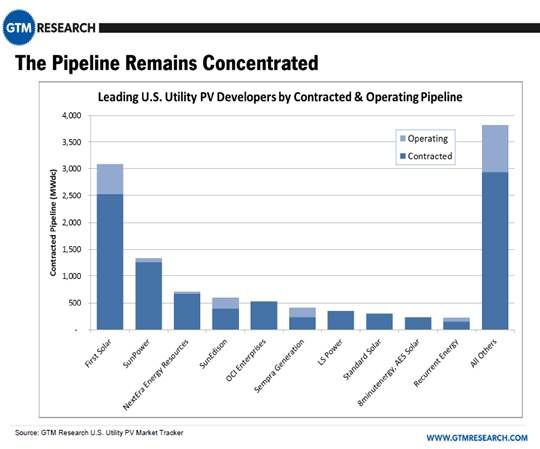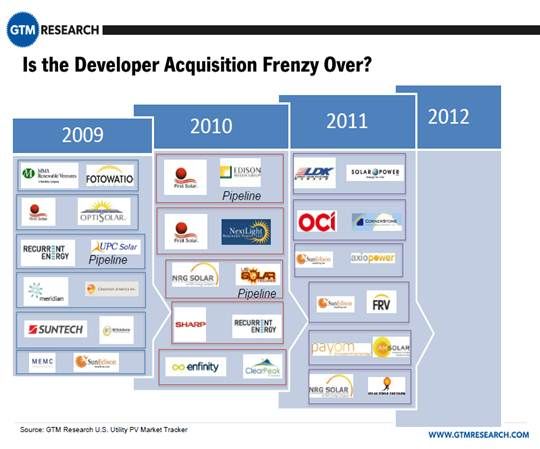The churn in utility-scale PV projects was the topic of GTM Research VP Shayle Kann’s conversation at the U.S. Solar Market Insight conference, with people who know where the investment money is and how developers see it.
Canadian Solar (NASDAQ:CSIQ) is “focused on two-megawatt to 30-megawatt projects,” Director Noah Eckert said. After coming in “at mid- to late-stage development” and moving Canadian Solar modules to it, Eckert said, Canadian Solar would sell the finished project to an independent power producer (IPP) “like an Exelon (NYSE:EXC) or an EON (PINK:EONGY) or a NextEra (NYSE:NEE)” and use the capital to begin the process again.
“We have found a robust number of projects in the market in the last year,” Eckert said. “Our approach has been project by project,” he explained, “unlike the MEMCs (NYSE:WFR) and First Solars (NASDAQ:FSLR) who went in and consumed a whole developer.”
Canadian Solar “led the charge to consolidation because we were the first to have an oversupply of panels. Now we see that on the developer side.”
One reason for solar merger and acquisition (M&A) activity this year, said Chadbourne & Parke Partner Evelyn Lim, is “uncertainty about what is going to happen with some of the tax incentives.” That has “some smaller IPPs looking to monetize assets, either their portfolio or individual projects.” Another reason is that other Chinese module manufacturers are coming in, Lim said, “to move their product.”
Buyers, she added, are “bidding low, expecting to get a deal, thinking smaller developers are desperate.” But with buyers shopping, developers see interest when market their projects, Lim said, and “think their assets are worth more.” There is not yet, she said, “a meeting of minds” on valuations.

“2011 was a record year for solar M&A activities,” said Marathon Capital Director Ani Rouskova, due to “supply manufacturers investing in building out their pipelines” and “supply manufacturers that had earlier bought pipelines looking to monetize them.”
The top ten operating U.S. solar PV assets, Rouskova said, “are all under 60 megawatts, and four or five have already changed ownership. I can’t see a lot of M&A in that sector.”
But the top ten assets under construction and in development “are all above 100 megawatts,” and though “seven or eight have changed ownership,” she said, developers in pursuit of capital are likely to create “a lot of activity in those at a later stage of development.” Especially, she said, if there is a PPA attached. “The trend today is high quality assets with PPAs.”
Quality, the group agreed, is fundamental to valuation. Projects must have a PPA, an assured interconnection, a quality EPC provider, well-defined owner objectives, schedule and payment structure flexibility, good vendors, a solid resource analysis and capital cost clarity.
Real estate issues must also be clear, Eckert added. It can be “as simple as making sure you get a 30-year or 35-year lease” for a twenty-year PPA. Without the extra years, “you just lost the potential ten-year merchant tail and the residual value that could help you monetize a second project.”
“We get to look at projects that are kind of messed up,” said Solar Land Partners CEO John Barnes. “The object is to fix the project to be bankable and sellable.”
New this year, Barnes added, “was a tremendous dropout of hundreds of megawatts of SREC-dependent New Jersey projects that real people will not invest in” because of the crash of the SREC market. But, he said, California’s reverse auction mechanism for one- to twenty-megawatt proposals produced “a whole bunch of real projects, won by real developers, at extremely low rates, that really push the IRR window.”
Eckert said valuations now range from $0.03, $0.04, or $0.05 per watt to perhaps $0.22 to $0.25, but “anybody looking for $0.30 or $0.40 in my world is crazy.”
“The $0.30 days are gone,” Barnes agreed. It is “pretty risky around $0.10.”
“We see investors bidding at around 8 percent in after tax IRR,” Rouskova said. “Last year, when there was more competition around acquiring a development pipeline, we saw panel manufacturers bid down to 7.5 percent or even less because they could have some panel margin.”

Buyers, Rouskova said, will be utilities, especially those with post-2014 tax capacity. “IPPs make sense,” she added, though they may have to partner with conglomerates and corporates. But, she said, deals like the recent Google (NASDAQ:GOOG) and Sumitomo (NYSE:SMFG) participation in Desert Sunlight “are few and far between.’
Energy players have tax capacity, but have not come in. Passive investors don’t yet understand how to build a tax structure or find a partner but the cost, time frame and yield expectations for their capital make them “a very interesting investor class.” The cost of pension funds’ capital makes them more appealing than infrastructure funds.
Sellers include non-balance sheet players, like smaller developers, Lim said. Many will try to tack a development pipeline onto the deal. “The more you want your money up front, the less value you get for the pipeline.”
The trend, she said, is “toward earn-outs.” If a developer “is willing to wait, there is some value in the pipeline.” Otherwise, such assets “are not being valued at all.”
“Upfront payment is approaching zero,” agreed Barnes. “You get the money at the end if the project is built. Everybody has to suffer along to make it work.”



